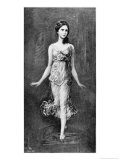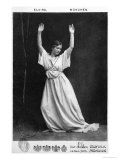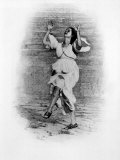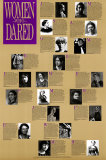|
|
||||||
|
||||||
|
|
||||||
 |
||||||
|
|
||||||
Isadora Duncan Posters, Prints, Photographs, Books,
|
||||||||||||||||||||||||||||||||||||||||||||||||||||||||||||||||||||||||||||||||
|
art & music > dance > ISADORE DUNCAN < notable women < social studies |
||||||||||||||||||||||||||||||||||||||||||||||||||||||||||||||||||||||||||||||||
|
Isadora Duncan posters, prints, and photographs for dance studios and social studies classrooms. Isadora Duncan, considered the "mother" of modern dance, was shocking to the American public but somewhat redeemed when Teddy Roosevelt said, “Isadora Duncan, seems to me as innocent as a child dancing through the garden in the morning sunshine and picking the beautiful flowers of her fantasy.” |
||||||||||||||||||||||||||||||||||||||||||||||||||||||||||||||||||||||||||||||||
“The dancer's body is simply the luminous manifestation of the soul.” Isadora Duncan Books My Life by Isadora Duncan - 1927. An account of Isadora Duncan's life in her own words. She states her art as a dancer is an effort to express the truth of her Being in gesture and movement. Isadora: A Sensational Life by Peter Kurth -brings to life "the most influential and the most notorious woman of the first quarter of the 20th century" (The New York Times Book Review); "one of the true visionaries of modern dance-and, by extension, of modernism in all its guises" (Washington Post); a performer who invented her own language of movement to express her needs for art and freedom; a woman whose life, set against the backdrop of Europe and the U.S. in the early 1900s, was crowded with love affairs, passions, and tragedies. (book description) Life into Art: Isadora Duncan and Her World- a collection of photographs and words describing Isadora Duncan's childhood, early years as a dancer, establishing a dance school, the tragic death of her children in 1913, and her own bizarre end. Done into Dance: Isadora Duncan in America by Ann Daly- Numerous excerpted sources and black-and-white photographs examining Isadora's international fame, as well as her profound influence on a generation of American women. Dance Was Her Religion: The Spiritual Choreography of Isadora Duncan, Ruth St. Denis and Martha Graham - Three dancers who changed the face of Modern Dance and liberated dancers from ballet’s rigidity to glorify the human body as a scared vessel: Isadora Duncan, 1877-1927, Ruth St. Denis, 1879-1968, and Martha Graham, 1894-1991. From youth, each recognized an organic urge for ecstatic human expression. This book explores their pioneering approaches to spiritual choreography and reveals unkown aspects of their lives and work: Isadora Duncan: Movement From the Soul - VHS - Isadora Duncan (1877-1927), the "Mother of Modern Dance," was a complex and charismatic rebel who dared to defy Victorian mores through both her art and the way she lived. In this illuminating and gracefully crafted documentary, excerpts from Duncan's speeches, essays and autobiography are interwoven with rare archival photographs, historic film footage and re-creations of twelve of Duncan's dances to provide a balanced and engaging portrait of one of this century's most outspoken and intriguing personalities. Duncan raised dance from mere vaudeville entertainment to a legitimate art form, laying the foundation for today's modern dance. Nietzsche's Dancers : Isadora Duncan, Martha Graham, and the Revaluation of Christian Values -Nietzsche uses images of dance throughout his work to represent the process and the fruits of his "revaluation of all values." American modern dancers Isadora Duncan and Martha Graham were inspired by his work as they created their respective visions for what dance can and should be. This book examines the relationships among these three figures, arguing that the techniques of dance practice, choreography, and performances developed by Duncan and Graham critically advance Nietzsche's revaluation of Christian values. (Nietzsche print) Isadora Speaks: Writings & Speeches of Isadora Duncan - This outstanding collection of the great dancer's heretofore uncollected writings and speeches gives us a vivid new perception of her importance as an original and radical thinker. Starting with reminiscences of her San Francisco childhood, Isadora Speaks features her outspoken views on America, revolutionary Russia, education and the arts, life with Russian poet Serge Esenin, love, woman's emancipation, and dance as a radical force capable of transforming the world and changing life. Prefaced by dance scholar Ann Barzel, this new edition also includes an updated foreword by Franklin Rosemont on Isadora's extraordinarily diverse and always expanding influence, and fifteen new illustrations. (book description) Barefoot Dancer: The Story of Isadora Duncan - Describes the life of the modern dancer who created a spontaneous, free-form dance style accompanied by literary readings and non-dance music. (ages 9-12) Basic Concepts in Modern Dance: A Creative Approach - Brief introduction to modern dance and body movement techniques beginning with an overview of the history of modern dance to basic body movement, improvisation, and choreography with simple exercises for dancers; also of interest for yoga, t'ai chi, and aerobic students. LINKS FOR LEARNING : ISADORA DUNCAN |
||||||||||||||||||||||||||||||||||||||||||||||||||||||||||||||||||||||||||||||||
|
|
|
|
previous page | top |
|
|
|
NPW home | Global PathMarker Collection | APWTW Blog | faqs-about | contact | search | privacy |
|
NetPosterWorks.com ©2007-2015 The Creative Process, LLC All Rights Reserved. |
last updated
















